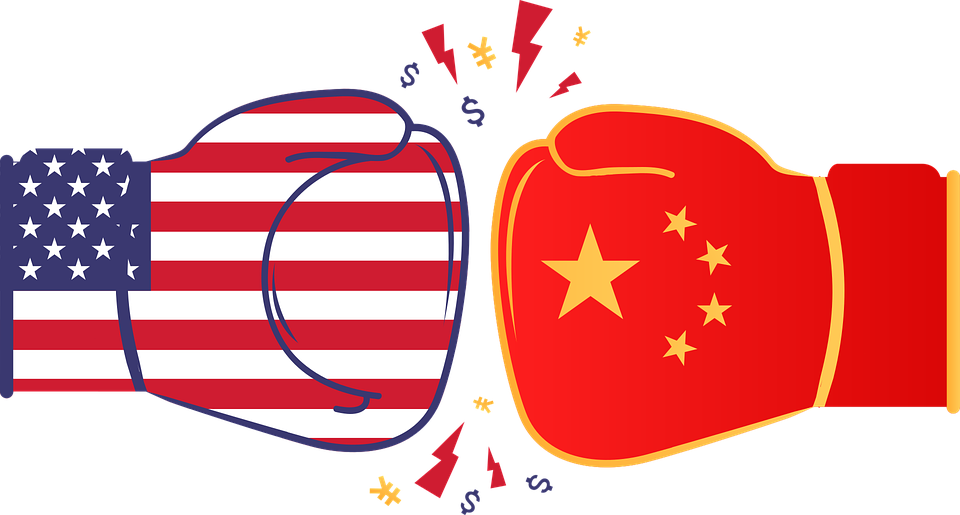By Alex Kaplan
The trade war between the United States and China has occupied news headlines for well over a year now, yet both sides are still unable to reach an agreement on a new trade deal. As the two parties remain at odds with one another, the global economy is stuck in a vulnerable position making stocks immensely volatile. To those Americans who see the trade war as an unsubstantiated conflict that is proving to be an inconvenience on the price of consumer goods: rest assured, there are legitimate reasons behind the bitter escalation in U.S.-China bilateral relations.
China’s tremendous economic development and military modernization have been spurred by leveraging American technology and resources. It is a genuine concern that China will surpass the U.S. as the world’s largest trade economy and become the world’s largest economy within the next two decades. The trade war has thus been both a symbolic and tangible way for [1] the U.S. to counter China’s growth and keep its greatest power antagonist in check.
China’s rise is a pertinent concern not only for Washington but for all Americans because it may signify the decline of American exceptionalism in the global economic and military landscape. This is a symptom of a broader trend in international politics dubbed by political scientist Ian Bremmer as a “G-Zero” world in which there is no single global leader — a transition from a U.S.-led world order. [2]
Military prowess and economic grandeur have been the cornerstone of American hegemony since World War II. China’s rapid development into a power that can challenge American uniqueness in these areas signifies very real truths that must be confronted as we approach a new moment in the political-economic order.
In considering how China’s growth manifested into immense economic and military power, it becomes clear that U.S. action against China is warranted. China has launched a multitude of state-led projects predicated on utilizing advanced technologies to reach goals that underscore military modernization, economic power, and political rejuvenation.
Through ambitious initiatives, China has engendered the rapid development of an “indigenous technology complex” with the aim of becoming a global leader in emerging technologies and military strength. In doing so, China has sought to rival the U.S. by taking [3] advantage of critical American technologies both domestically and abroad. Through encouraging forced technology transfers (FTT) in China and channeling massive amounts of investment into U.S. companies located in America, China has cost the U.S. billions in IP theft annually and exploited American innovation. [4]
Chinese firms are trying to get their hands on as many cutting-edge technologies with potential military applications as they can, especially artificial intelligence (AI), making their rise a matter of national security. China’s push for AI advancement gained momentum in July 2017 [5] when The State Council of China released the New Generation Artificial Intelligence Development Plan. This policy outlined China’s strategy to cultivate a burgeoning AI industry. [6] The CCP aimed for its companies and research facilities to be a global leader in AI by 2030.[7] China’s new cruise missile system with a “high level” of AI already shows the nature of the technological advancements they are making. Known as the Long Range Anti-Ship Missile, the “semi-autonomous” weapon uses AI technology to avoid defenses and make final targeting decisions, according to the Pentagon. [8]
To further their technological development in these key areas, Chinese firms have invested heavily in American start-ups that are pioneering sensitive technology engineering. Many Chinese firms engaged in these activities belong to state-owned companies or have connections to Chinese leaders, making U.S.-China business deals a source of concern for Washington. For instance, the Boston-based AI start-up, Neurala, whom the U.S. Air Force approached to make military robots, received seed money from a state-run Chinese company when the American military failed to invest. [9]
The rise of China thus naturally invites retaliation from the U.S. Donald Trump has acted on long-existing concerns surrounding China’s rise and unfair business practices. In doing so, rounds of tariffs have been used as a retaliation mechanism. Consequently, the economic sanctions have devastated China’s economy to the extent that China is experiencing its lowest GDP growth in 27 years.[10]
The entanglement of economic and military factors is fundamentally associated with geopolitical risk which is alarming for not only the U.S. but the international community. Regardless of how the trade war plays out, the outcome, and subsequent interactions between the U.S. and China, will have vast implications on business, technology, trade, finance, and every other aspect of our emerging bipolar world. [11]
Endnotes
- “Is China a Threat to the U.S. Economy?” ChinaFile, December 19, 2016.
- “Welcome to the G-Zero World.” Harvard Business Review, March 30, 2015.
- “The Next Digital Superpower: Scenarios for the US-China Conflict and Implications for the Global Economy.” Vontobel Corporate Finance. Accessed December 7, 2019.
- Keown, Alex. “Chinese Company Slows Down Investment in U.S. Biotech Sector Due to Trade Issues.” BioSpace. BioSpace, May 31, 2019.
- Mozur, Paul, and Jane Perlez. “China Bets on Sensitive U.S. Start-Ups, Worrying the Pentagon.” The New York Times. The New York Times, March 22, 2017. https://www.nytimes.com/2017/03/22/technology/china-defense-start-ups.html.
- “AI Policy – China.” Future of Life Institute. Accessed December 7, 2019. https://futureoflife.org/ai-policy-china/?cn-reloaded=1.
- Ibid.
- “China Eyes Artificial Intelligence for ‘Fire-and-Forget’ Cruise Missiles.” South China Morning Post, July 20, 2018.
- Mozur, Paul, and Jane Perlez. “China Bets on Sensitive U.S. Start-Ups, Worrying the Pentagon.” The New York Times. The New York Times, March 22, 2017. https://www.nytimes.com/2017/03/22/technology/china-defense-start-ups.html.
- He, Laura. “China’s Economic Growth Slumps to Lowest in 27 Years as the Trade War Hits.” CNN. Cable News Network, July 15, 2019. https://www.cnn.com/2019/07/15/economy/china-gdp-growth/index.html.
- “The Next Digital Superpower: Scenarios for the US-China Conflict and Implications for the Global Economy.” Vontobel Corporate Finance. Accessed December 7, 2019.






Be First to Comment